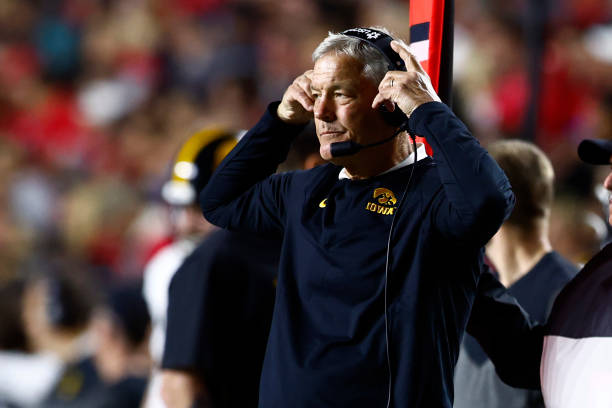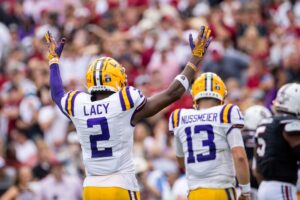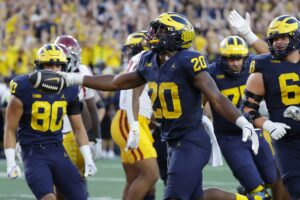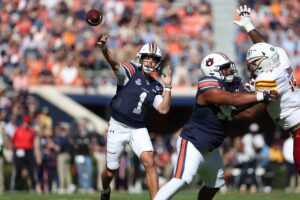What’s wrong with the Iowa offense? According to offensive coordinator Brian Ferentz, the offensive struggles this year “don’t have a root cause.” At the halfway point of the season, Ferentz’s offense is dead last in the FBS in total offense (238.8 yards per game) and first downs per game (13.3). The unit is among the 10 worst teams nationally on the year in scoring offense (14.7 points per game), red zone attempts (12), third-down conversion percentage (29.6%), and scrimmage play of more than 10 yards (48).
There isn’t one obvious area that needs attention in this offense. Lack of depth at wide receiver, youth at the offensive line, and failure in critical down situations have been among the reasons Iowa has struggled this season. It doesn’t all fall on one person, but the entire unit together. More than anything, the 2022 season might just be more of a rebuilding year than originally anticipated.
Change for Change’s Sake
At Wednesday’s coordinator press conference, Ferentz made an interesting comment in response to questions about his starting quarterback. Chad Leistikow of the Des Moines Register asked him what the downside would be of making a switch at the position and going with Alex Padilla.
The junior from Colorado has been the number two guy all season. He has yet to take a snap despite the continued lack of production on offense. A switch in the position is something that would at least provide a change of scenery, something we thought would be reasonable nearly a month ago.
The first words of Ferentz’s response were, “What’s the upside?” Immediately, the answer seemed to discredit Padilla and signal an overall resistance to change. Ferentz and his father, head coach Kirk Ferentz, have continually expressed confidence in Padilla as a backup. This response indicated otherwise.
Looking deeper, the question that needs to be asked is which quarterback, given the circumstances of the Iowa offense, gives the team the best chance to win football games. It’s apparent through what we’ve seen on the field and bluntly confirmed by Ferentz in his press conference, that Spencer Petras is that guy. Petras is the most equipped to handle the lack of receiver depth, the young offensive line, and the difficulties these present for an offense. The offensive coordinator addressed making a change for change’s sake, saying that he doesn’t disagree with that philosophy. However, there are times when that kind of change makes sense and times when it may not. Right now, given the circumstances of a young, and not quite cohesive offense, it doesn’t make sense to the coaching staff to make that kind of change.
Offensive Line Youth
Against the Illini last time out, Iowa started four sophomores and a redshirt freshman at offensive line. Just two years ago, those five were playing high school football. Three of the five guys were four-star recruits out of high school. That includes center Logan Jones, who was recruited as a defensive lineman and made the switch to center this year. It’s a talented group up front, but a very young group.
The Iowa Hawkeye football program has long been a developmental program. There are typically only a handful of guys that Iowa lands in recruitment that are ready to play at the college level within a year or two. The offensive line is one of the more physical position groups on the field, if not the most. It takes time to develop these athletes into the physical specimens that the program seemingly sends to the NFL Draft every season.
Ferentz said in his media availability on Wednesday that there are guys playing who, quite simply, are playing before the coaching staff expected them to play. It’s not a knock on the players themselves. Rather, it’s situational and based on a lack of veteran availability at the position. Iowa’s 2019 recruiting class would be seniors right now. Among that group on the offensive line, the Hawkeyes landed four recruits, two of which were four stars. At this point in the 2022 season, one is out for the year (Justin Britt) and two of them have transferred. Tyler Endres is the only other recruit on the active roster from that class, and he has not appeared in a game this season. Nick DeJong was a walk-on that year and has seen the field in five games thus far in 2022. Veteran presence is key up front, especially given the scheme of Iowa’s offense. The lack thereof has been critical in the team’s shortcomings on offense this season.
Pass Catcher Depth and Predictability
For the first two games of the season, Iowa had just one scholarship wide receiver on the field. It was Arland Bruce IV, who had 14 targets and six catches in those two games. Nico Ragaini made his return to action in week three against Nevada. Since then, he and Bruce IV have been the only two wide receivers with meaningful targets. This has led to an emphasis on the tight ends, who have generally played well all season.
The tight ends, Sam LaPorta and Luke Lachey have been targeted a total of 64 times this season. The rest of the team has combined for 98 targets. Nearly 40% of the time Petras has dropped back to throw, the ball has gone to a tight end. Last week against Illinois alone, the two were targeted on 17 of Petras’ 36 attempts. The tight-end targets aren’t necessarily a bad thing if working. Against the Illini, LaPorta had 100 receiving yards, the second most in his career.
Critical Down Predictability
Where it starts to go wrong in the passing game is predictability in critical down situations. On third down passing situations against Illinois, the ball went to a tight end on nine of the 12 total attempts, 75% of the time. On third down in the last four games, the Hawkeyes threw the ball to a tight end or Bruce IV on 20 of 35 attempts, 57%. The first two games against Iowa State and South Dakota State were left out of this because Bruce IV was the only scholarship receiver on the field, inflating his target count.
This pass distribution reveals a predictable tendency in third-down passing situations. This tendency is not the fault of Petras alone. For starters, there haven’t been a lot of guys to throw to this season. Depth at pass-catching positions has been shallow. Given that there are only a few dependable targets who have been on the field consistently. LaPorta and Bruce IV are two of them. Further, the young offensive line has been leaky, allowing 70 quarterback pressures on 187 total dropbacks. Almost 40% of the time Petras drops back into the pocket, he faces pressure. When pressured, it becomes difficult to look past the first or second read, leading to those predictable targets. Combining these difficulties makes for a predictable offense that’s susceptible to failure on third down, leading to stunted drives, resulting in a lack of scoring.
What’s Wrong With the Iowa Offense?
It’s not an overnight fix or even a fix that can happen in the bye week. Whether it’s offensive line development or receiver depth, it will take time to overcome. However, there are small steps that can be made to the Iowa offense going forward this season. The elimination of negative plays, as Ferentz mentioned in his press conference, is critical. Iowa has allowed nearly seven tackles for loss per game this season for negative 200 total yards. That’s the ninth-most yards given up on tackles for loss nationally.
The Iowa offense has started with the ball inside their opponent’s 35-yard line six times this season. Those six possessions have resulted in 13 points, a fumble, a missed field goal, and a punt. The bottom line is that those possessions need to result in six points. This year, Iowa’s margin for error is thinner than ever and is resulting in losses. The Hawkeyes have to capitalize in those plus-field position situations in order to win. “Making the makeables” is one of the points Ferentz alluded to in his presser. Touchdowns in plus territory are makeable, but overall growth in this offense is going to be more of a long-term fix. However, the elimination of negative plays and capitalizing on advantageous territory will be critical for the Hawkeyes’ push for bowl eligibility.






